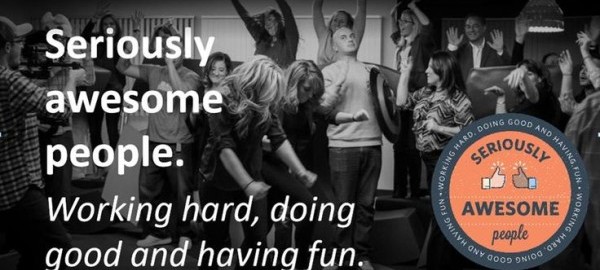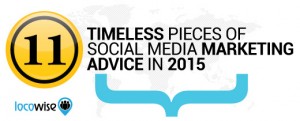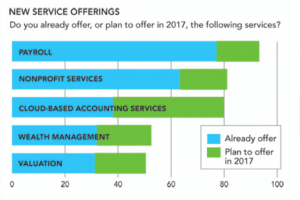A poor hiring decision can leave its mark on your business.
While monetary loss might be the first cost that comes to mind, a bad hiring decision also has the power to negatively impact employee satisfaction, customer experience, and the overall productivity of your business.
A recent survey from online employment website, Careerbuilder, revealed that 4 out of 10 employers reported a bad hire cost them at least $ 25,000 in the past year. For small businesses where employees wear many different hats, the cost of bad hire is estimated to be about eight times higher.
If you are a small business owner, you know there is very little margin for error.
Even at a public company like Constant Contact, where teamwork is critical and culture is king, we do everything we can to make sure every person we bring on board is a great fit.
As the head of Talent Acquisition, my team and I work to hire employees we like to refer to as “seriously awesome people.”

To help you do the same, let’s take a look at 5 of the most common mistakes to look out for when hiring for your small business.
1. Thinking you can “wing it”
Ever hear the saying ‘It’s hard to find something if you don’t really know what you are looking for’?
Don’t make the mistake of only having a general idea of what your role requires. You should go into the hiring process with a clearly outlined plan and an established set of expectations.
It’s common to have a general understanding of what the job requires, but have you really thought through the specific skills, abilities, and qualities needed to be successful in the job? Is this clear in the job description? Is it clear to your other employees and team members?
Tip: Outline and define the critical success factors for specific roles within your business. This will eliminate doubt or ambiguity, establish the ideal candidate “profile”, and keep you focused on what matters. Yes, it takes time — which is something that you don’t have a lot of — but by investing this time upfront you will save yourself headaches (and more time) later on.
2. Being fooled by the resume
Let’s be honest, a resume is nothing but an embellished list of accomplishments.
Think I’m kidding? In another survey released by Careerbuilder it was reported that 57 percent of hiring managers had discovered exaggerations or fabrications in applicant’s resumes.
And according to employee background screening company HireRight , there is a 27 percent discrepancy rate in employment histories based on more than 290,000 employment verifications conducted in the United States during last six months of 2014 alone.
The purpose of a resume is to get noticed, period. It’s a self-marketing tool, nothing but a ticket to get in the park, but not to ride.
There are all kinds of grey areas to be aware of around skill sets. For example, let’s say a candidate claims that they are bilingual in English and Spanish on their resume. Well, 4 years of Spanish in school and the ability to read in Spanish is not the same if your job requires the candidate to speak and interact with customers who speak fluent Spanish. There is quite a bit there that can be lost in translation (pun intended).
The point here is that the skills listed on resumes need to be thoroughly vetted out.
Tip: Probe. Ask an applicant where a specific skill or trade listed on their resume was applied to their job. How did that skill or accomplishment impact the success of the team or business?
3. Not going beyond skills and abilities
Guess what the best predictor of future behavior is?
Past behavior.
Understanding how well a candidate will act or react while on the job is critical, so take the time to think through the day-to-day challenges that are unique to your business and ask your candidate how they have handled similar circumstances.
Even if the experience is brand new to them, you can ask them what they would do in a specific situation.
This is called behavioral and situational interviewing. The goal is to solicit the stories that will predict how an applicant will respond and behave when placed in that situation in your job. This practice can really help improve hiring results.
Here is an example: Let’s say last week you had a really angry customer and you worked with that customer to find a successful outcome. What was it that you did in that situation? How did you do it? Take this example and now put the applicant through a mock situation.
In addition to instinct, try to get a feel for their interests as well — maybe an applicant has the right skills to do the job, but why do they want to do it? Just because the candidate has done the job before doesn’t mean that they are motivated or passionate about it.
Tip: Once you are done with the job description, take the time upfront to list your interview questions out and categorize them into a framework of three main areas: Technical (Can they do the job?) Behavioral (How will they respond/behave on the job?) and Motivational (Why do they really want this job?)
4. Thinking of hiring as a one-way street or dead end
As a small business owner, you’re used to thinking of every person you interact with as a potential customer. You work to make sure everyone who visits your business walks away with a great experience. Even if they aren’t ready to buy right away, they should walk away feeling good about your business.
Similarly, you want to make sure your candidates have a great interviewing experience. This includes allowing them to “interview” you about your business as well.
What about the candidates who don’t get the job? You still want them to have a good experience. This includes being transparent and giving them feedback on why you didn’t select them for the role.
Also, once a hire is made, don’t make the mistake of thinking the job is done. Hiring not a dead end, it is the beginning of the journey, now you need to set that person up to succeed by onboarding them.
Tip: Establish the mindset in the interview process that you are hosting candidates that you are interviewing like you would host customers. Maybe offer them coffee or water when they arrive, show them around, put them at ease and allow ample open time for them to ask you questions.
Then, once you hire someone for the job, remember to create a plan to successfully integrate that person into your business through any training, coaching, and information sharing. We’ll talk more about onboarding your new employees in my next blog post.
5. Ignoring culture fit
It is really easy to be blown away by smarts and experience, but remember that a big part of success comes from how well a candidate fits in with your team. What good is it if your hire is the smartest applicant on paper if they can’t be successful working within your business?
For this reason alone there have been countless case studies and books written on the importance of company culture and hiring for “fit”. Hiring an applicant that doesn’t fit in well with your company culture can have many negative consequences on your business.
Tip: Establish a set of values for your business to make applicants aware of. You can even create a standard set of interview questions to ask every candidate to evaluate culture fit.
For example, at Constant Contact we have a set of 3 core values. These values are:
- Customers First, Always
- Make It Happen
- Seriously Awesome People
Everything we do as a company end-to-end comes back to these core values and these values are a foundational element of our company strategy.
Hiring the right way, every time
Hiring is not a decision to be taken lightly. You want to put in the effort and avoid these common mistakes so that every member of your team is an asset and someone you can trust.
Start today by making a list of the core values of your business and thinking about what qualities will align well with these principles. The better understanding you have, the better you can communicate and set expectations for current and future employees.
Want to know how to use email and social media to find your next successful employee? This post can help!
(300)









